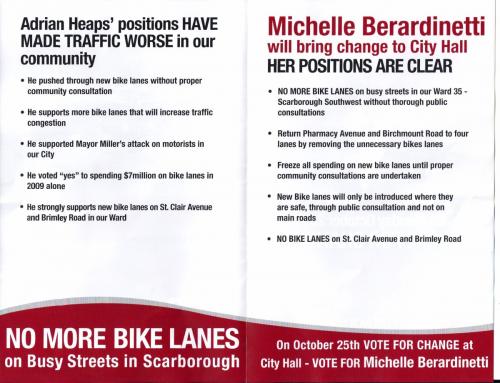(Photos by Tino)
From the Urban Repair Squad folks a two-way sharrow on Macdonnel St in Parkdale. The Torontoist has a good post and interesting comments:
Longtime Urban Repair Squad documentarian Martin Reis says he first spotted the symbols over the weekend. "Toronto has so few real good north-south connections, especially in the west end," Reis explained to Torontoist. "I mean, the west end is a giant black hole of no bike infrastructure." Add that to the experience of biking north on a street, facing-down cars travelling south, and "it's a bit nerve-wracking," Reis says.
The official City inventory of bike infrastructure includes one-way sharrows and also contra-flow lanes to allow cyclists to go both ways on one-way streets for cars. The URS "innovation" is interesting, even if there are bound to be reservations about encouraging cyclists to travel over the same sharrows in both directions. If there was some reasonableness in this idea, perhaps there should be sharrows on both sides of the streets so cyclists can bike on the side they'd normally be expected to bike. But that isn't entirely the point, likely. A two-way sharrow catches the eye and makes one think "Why not?"
The comments includes the precautionary ones:
Going the wrong way down a residential street is just dangerous. It confuses drivers, and it puts the residents of the street in danger. On a one way street (like the one I live on) kids are used to looking in only one direction to see if it safe to cross. A silent bicycle zooming along usually is very surprising to the person walking out onto the street. Bikes should follow rules for safety and good manners. Usually there will be an equivalent one way street one street away. Dont be so lazy! Douchbags!
as well as the practical:
- Cycling the 'wrong' way on a one-way is not dangerous. You might think it's dangerous, but there is no evidence to prove that it is.
- Not all one-way streets in Toronto are the same width. Some were built with the intention of being two-way, but residents on the street lobbied to have them one-way to limit non-local traffic. Brunswick from Wells south to College is good example of this. It's as wide as other two-way streets and alternates one-way north to one-way south fives times (at nearly every intersection).
- Bicycles are only "vehicles" because of an ancient clause in the Highway Traffic Act - the clause also includes horses and buggies... Just because something is law doesn't mean it's right.
I've never been convinced that the prohibition against cyclists travelling the wrong way down one-way streets is about safety. Not only do many Toronto cyclists do this every day, but other jurisdictions such as in German cities, allow cyclists to do this. A contra-flow lane in Toronto reinforces this movement.

